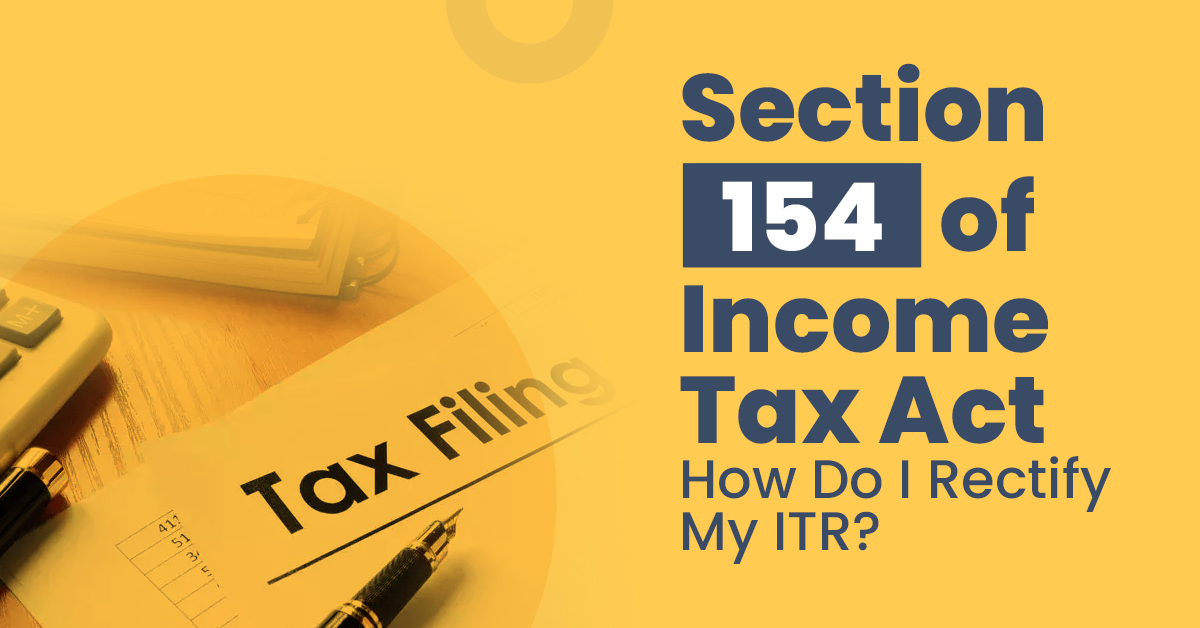How Do I Rectify My ITR? Section 154 of the Income Tax Act Explained


In India, ‘filing an IT return’ refers to the process of submitting a tax return to the Indian Income Tax Department. This document declares the income earned during a financial year and the tax paid on that income.
It is a legal requirement for all individuals and entities (such as businesses) in India to file their IT returns if they meet certain income thresholds.
The process of filing an IT return involves calculating the tax liability based on the income earned, claiming any applicable deductions and exemptions, and paying any taxes due.
The IT return is then submitted to the Income Tax Department using an online portal or through a tax intermediary, such as a chartered accountant (CA).
Filing an IT return is important because it helps you meet your legal obligations and ensures that you pay the correct amount of tax.
It enables the government to track and assess the tax paid by individuals and entities, which helps fund public services and infrastructure.
The task of processing your income tax returns (ITR) is critical. This process is also quite arduous and typically involves many steps. Thus, an error during this process is not uncommon.
Section 154 of the Income Tax Act of 1961 was introduced as a provision to cater to the aftermath of such errors in filing the ITR.
Section 154 involves the rectification of any mistake apparent from the record in an order passed by an assessing officer.
Let’s break this down to make sense of it.
What Is ‘Mistake Apparent From The Record?’
‘Mistake apparent from the record’ is a term used in the Indian Income Tax Act to refer to errors or mistakes that are obvious, glaring and patent.
A mistake apparent from the record should be self-evident and not just an arithmetic or clerical blunder, as rightly highlighted in the Supreme Court’s decision in T.S. Balaram, ITO v. Volkart Brothers. The error should not be derived based on the long-drawn reasoning of two opinions that could have been true.
What Constitutes a Record?
The term “record” refers to the entire proceedings, not just the assessment order.
In other words, all the documents and materials that you provided during the proceeding and were available to the assessing officer at the time of passing the order constitute a record.
It is important to keep in mind that the assessing officer can only examine the materials and documents that are available at the time the order is passed.
During the process of rectifying the mistake, no new evidence or materials can be examined (Gammon India Vs. CIT).
Which Orders are Eligible for Rectification?
For an order to be eligible for rectification under the provisions of Section 154 of the Income Tax Act, the mistake must be apparent from the record – an obvious error capable of being rectified without the need for any further inquiry or investigation.
An apparent mistake is eligible for rectification for:
- Any order passed under any provisions of the Income Tax Act.
- Any intimation or deemed intimation sent under Section 143(1).*
- Any intimation sent under Section 200A(1) [involves processing of TDS returns].
- Any intimation sent under Section 206CB [involves processing of TCS returns].
* If a notice is served under Section 143(2) to ensure you have not underpaid tax in any manner, then the same cannot be subject to rectification.
Can an Order Already Subject to an Appeal or Revision be Rectified?
Yes, if the order passed is already subject to an appeal or revision, your tax officer will be eligible to rectify your order for all matters except for the one that is subject to the appeal or revision. This is commonly known as the “doctrine of partial merger.”
For instance, if there are three subject matters to your order (one of which is subject to appeal), your tax officer may rectify the other two matters under Section 154.
Who Can Initiate The Rectification?
Under the provisions of the Indian Income Tax Act, the rectification of mistakes apparent from the record can be initiated by the Income Tax Department.
This means that the department has the authority to identify and correct any errors or mistakes that are apparent from the records or documents available to it without the need for the taxpayer to file a separate application for rectification.
If the Income Tax Department initiates the rectification of mistakes apparent from the record, it will issue a notice to the taxpayer, informing them of the proposed rectification and the reasons for it.
The taxpayer will have the opportunity to review the proposed rectification and raise any objections or concerns that they may have.
The Income Tax Department will then consider the objections and decide whether to proceed with the rectification.
Alternatively, the taxpayer can also apply for rectification under Section 154 if they deem it fit.
An application by the tax collector or deductor is also eligible for rectification.
Time Limit for Rectification
As per Section 154, the applicant (tax authority, taxpayer or tax collector or deductor) should send the application for rectification before the expiration of four years from the financial year in which the order sought to be rectified was passed.
Let us take an example to understand the timeline.
Assume the intimation sent to you under Section 143(1) is to be rectified. This intimation was sent to you on 21st December 2022 which falls in FY2022-23.
The time limit for rectification of this intimation would be four years after the end of FY2022-23.
Thus, you should file the application for rectification before the end of four years from April 1, 2023, i.e., by March 2027.
If you read the words of the law, you would notice the phrase ‘order sought to be rectified.’
What Does Order Seek to be Rectified Mean?
The order sought to be rectified refers to the order that was passed by the assessing officer and which has a mistake apparent from the record. It does not necessarily mean that the original order was passed by the tax authority.
Take a look at this example.
Assume your initial order for an initial tax assessment was passed on 2nd August 2008. The order discusses three subject matters – A, B and C.
The same was picked for rectification for subject matter A by the assessing officer. The order for rectification under Section 154 was passed on 5th July 2011.
Subsequently, you noticed a mistake apparent from the record for subject matter B.
Since subject matter B was not discussed in the first rectification order, the ‘order sought to be rectified’ here remains the original assessment order, not the rectification order passed on 5th July 2011.
Therefore, the time limit of four years from the end of the financial year will be calculated as of 2nd August 2008.
As iterated in Hind Wire vs. CIT, the mere passing of a subsequent order does not change the rectification time limit unless the matter to be rectified is the subject matter of the subsequent order.
When Will the Assessing Officer Pass the Rectification Order under Section 154?
When the income tax authorities or you file a request for rectification, the assessing officer must issue an order within six months of the end of the month in which the request was made, approving or rejecting the claim.
If you applied on 3rd January 2022, the time limit for passing the rectification will be six months from the end of January 2022, i.e., 31st July 2022.
Can the Assessing Officer Review the Return Under Section 154?
No, while rectifying the order under Section 154, the assessing officer cannot review or reassess.
For example, assume your tax return was subject to appeal and the income tax authority passed an order in conformity with a Supreme Court justice.
Later, the appeal order was subject to rectification. The income tax authority, while passing the rectification order under Section 154, assesses it by recalculating tax based on another Supreme Court justice.
In such a case, the income tax authority cannot review the order by recalculating the tax based on another Supreme Court judgement, as that does not constitute a ‘mistake apparent from the record.’ [CIT vs. United Mercantile Co. (P) Ltd.]
What Will be the Impact of Rectification?
As a result of the rectification, your computed tax payable may either increase or decrease.
If the rectified order increases your tax, the assessing officer will assume notice and provide a reasonable opportunity to be heard.
On the other hand, if the rectified order results in reducing your tax, the assessing officer will issue you a refund.
How Do I File an Application for Rectification Under Section 154?
These procedures must be followed if you want to submit a rectification application under Section 154:
1. Visit the tax e-filing site and log into your account.
2. Select rectification under the “e-file” tab in the header menu.
3. Type your PAN into the appropriate fields, choose the order or notification that needs to be validated, and then select the assessment year from the menu.
4. A page including information on your PAN details, ITR, financial year, assessment year, the most recent intimation number issued, your e-filing acknowledgement number, and a drop-down menu to choose the type of request will be displayed.
You will have the following four choices to choose from:
- Correcting tax credit inconsistency
- Correction of return filed
- Reprocessing the return
- More information regarding Section 234C
- When you select the first checkbox, a list of alternatives such as TDS, TCS, and Income Tax details displays. Submit by selecting the appropriate item.
- If you opt for the second option, you must download the most recent utility form and generate an XML with the filing type set to “rectification.”
- You have the option to examine your Form 26AS for a tax credit mismatch before submitting it if you merely want to reprocess the return.
- If you decide to add details for 234C, you must first complete the information regarding the type of income under each section before submitting.
Frequently Asked Questions
Can I withdraw or refile my rectification request after it has been made?
You cannot take back rectification requests that have already been sent. You may file another rectification request only after the previous one has been processed by the CPC.
Can I file an appeal in response to a rectification order?
Yes, you can file an appeal directly to CIT(A) against a CPC intimation order.
How do I fulfil the outstanding tax demand on Section 154?
Challan 280 can be used to pay tax obligations. This challan can be completed online at TIN-NSDL, and the demand can be paid using debit cards, online banking, or other methods.
Can I make two revisions to my tax return?
You may submit a revised return as many times as you like.




